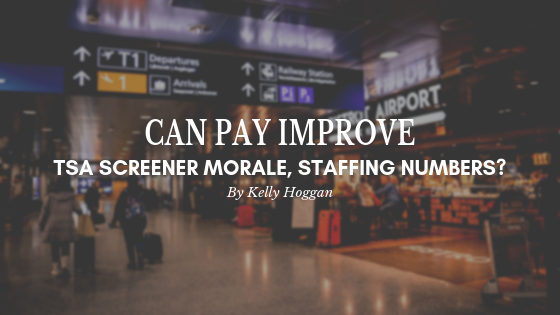From H4 Solutions:
According to a June 12, 2019 article in the Washington Post, Transportation Security Administration security screeners are “short-staffed, poorly paid and suffering meager morale.” What’s also worrying, is that the situation for TSA screeners (or “Transportation Security Officers,” as they’re officially known) is likely to worsen by next year. And unfortunately, the chronic short-staffing issue is nothing new to the government security agency, as 2006 news reports, as well as government inspector general findings, reveal. Indeed, air travel has increased so much since TSA’s creation that it’s overwhelmed the agency’s ability to increase staffing in response
What to do about understaffing of TSA’s screener corps who, after all, are the agency’s frontline employees and the security people whom air travelers interact with the most? TSA is predicting a 4.5 percent increase in traveler numbers just for the 2020 fiscal year but requested only enough funding to increase staffing by 2.5 percent. This development doesn’t seem to be too helpful. As well, this shortfall would also continue to exacerbate the understaffing problem among TSOs. Screener understaffing also wouldn’t help improve travelers’ attitudes as they make their way through what promises to be even longer security lines next year.
Solutions do exist, though. For starters, former TSA administrator John Pistole writes in a July 15, 2019 opinion piece in the Washington Examiner that Congress should stop diverting money from the security fee already paid for by travelers.
Ostensibly, the “Sept. 11 Fee” is supposed to finance the cost of providing security for the nation’s transportation system, and with record-high air travel for the last several years plenty of money from the fee has been collected. But, as the Policy Genius website notes, Congress has a lamentable history of diverting the money to fill budget gaps as well as to “pay down” the national debt. Pistole himself maintains Congress diverts up to one-third of the funds to other government programs or the debt.
The amount of money from the Sept. 11 Fee that goes to the debt varies according to sources but is generally conceded to be less than one billion dollars on a current debt of 22 TRILLION dollars. The percentage is a number so infinitesimally small as to amount to 0.00 on most calculators. In other words, it’s a microscopic rounding error in terms of what’s applied to that $22 trillion figure, and it’s not helping in the least.
As we noted in a previous article on TSA screeners, pretty much everyone in government and the airlines concedes there are problems with low screener morale and high screener turnover. Evidence for such problems is provided in a May 2019 article at the Travel Weekly website. And it’s only going to become more severe as air travel numbers continue to increase while TSA staffing keeps lagging.
There’s little doubt the above issues help create long security lines at airports as TSA juggles a poorly paid corps of screeners to cover its airport operations fully. Security line issues are also a phenomenon readily observable by even occasional air travelers. These passengers are the ones who may end up spending much time in a security line, depending on the day of the week and time of year (especially during the ultra-heavy summer and holiday travel periods).
Given this, why aren’t we using the entire Sept. 11 Fee and putting it toward its intended purpose, which is to help improve security? The amount of money from the fee already being collected would not only fund improvements in screening technologies, but it would also fully cover pay raises and staffing increases for TSA screeners. Agency TSOs, after all, are the lowest-paid group within TSA and are also likely among the lowest-paid government workers.
Regrettably, rather than address TSA’s chronic understaffing issue in partnership with the security agency, Pistole says airports are instead pressing Congress to increase the cap on the Passenger Facility Charge. The PFC itself isn’t directly intended to provide for airport security needs and is usually meant to help improve facility infrastructure. Airport administrators, though, are claiming that raising the PFC will help security at those facilities, something the ticket fee was never intended to address and hasn’t tackled in the past. Increasing the facility charge presents another problem, though, when you consider that a healthy portion of an airline ticket’s price is already made up of government-imposed taxes and fees.
Together, the Sept. 11 Fee – which is supposed to help provide funding for TSA – and the PFC are but two of 17 separate taxes or fees imposed on an airline ticket, which already comes packed with additional costs. In some cases, these fees can add tens or even hundreds of dollars to the price of some international tickets as well as to multi-stop domestic tickets.
A ready solution to inadequate pay for TSA security screeners as well as the agency’s understaffing problem already exists, and it can be implemented without costing air travelers or taxpayers a single dime. All that’s needed is for Congress to stop diverting funds — more than a billion dollars worth — from the Sept. 11 Fee and to apply all of it towards transportation security needs, including the TSA’s. Today, only a little over 50 percent of the security agency’s annual budget comes from the fee while the remainder is provided by Congress via its appropriations process.
Once given the money from the Sept. 11 Fee it’s entitled to, TSA can address screeners’ woeful pay as well as recruit enough of them to handle increasing travel numbers. With it, the Transportation Security Administration could easily provide a general, across-the-board pay raise of over 20 percent for all frontline TSO employees– amounting to less than half the amount redirected towards paying down the national debt and away from the agency. This amount would immediately address the three major pay concerns plaguing the agency: starting pay rates, average pay rates and increasing top-end rates for tenured screeners who have not seen a raise in years. All three are the major driving factors for attrition among the TSO workforce. It bears repeating that the bump in pay would be at no cost to taxpayers or the traveling public. The entire raise would be paid for by monies already generated by the fee and currently being diverted by Congress on a regular basis.
Such pay raises would bring screener pay to about $23 hourly and provide a living wage in line with the lower average among federal workers. They would also increase screeners’ morale and reduce the acute turnover which currently exists. Air travelers – who are directly affected by such issues as they make their way through security lines — would, without a doubt, be highly pleased with such outcomes.
Kelly Hoggan, Founder and CEO of H4 Solutions, previously served as assistant administrator for operations at the Transportation Security Administration. In that role, he was responsible for aircraft and checkpoint security operations at the nation’s 400-plus commercial airports.


